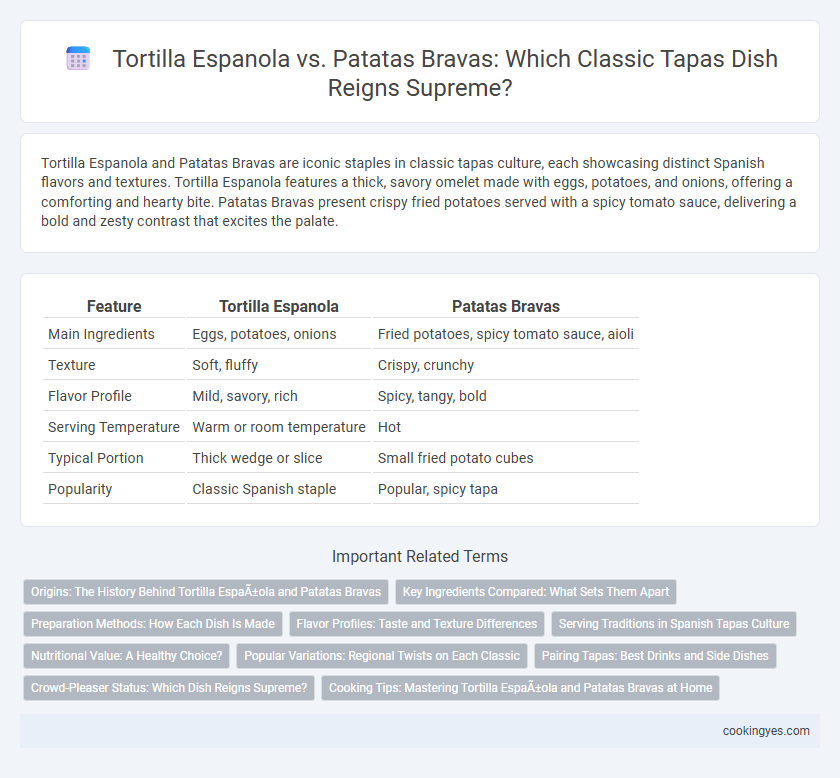Tortilla Espanola and Patatas Bravas are iconic staples in classic tapas culture, each showcasing distinct Spanish flavors and textures. Tortilla Espanola features a thick, savory omelet made with eggs, potatoes, and onions, offering a comforting and hearty bite. Patatas Bravas present crispy fried potatoes served with a spicy tomato sauce, delivering a bold and zesty contrast that excites the palate.
Table of Comparison
| Feature | Tortilla Espanola | Patatas Bravas |
|---|---|---|
| Main Ingredients | Eggs, potatoes, onions | Fried potatoes, spicy tomato sauce, aioli |
| Texture | Soft, fluffy | Crispy, crunchy |
| Flavor Profile | Mild, savory, rich | Spicy, tangy, bold |
| Serving Temperature | Warm or room temperature | Hot |
| Typical Portion | Thick wedge or slice | Small fried potato cubes |
| Popularity | Classic Spanish staple | Popular, spicy tapa |
Origins: The History Behind Tortilla Española and Patatas Bravas
Tortilla Espanola, a traditional Spanish omelette made with eggs, potatoes, and onions, originated in the early 19th century in Castilla-La Mancha as a simple, hearty dish for rural workers. Patatas Bravas, consisting of crispy fried potatoes served with a spicy tomato sauce, emerged in Madrid during the mid-20th century, reflecting post-war urban culinary innovation. Both tapas exemplify regional Spanish flavors with Tortilla Espanola highlighting rustic heritage while Patatas Bravas showcases modern city influences.
Key Ingredients Compared: What Sets Them Apart
Tortilla Espanola features key ingredients like eggs, potatoes, and onions, creating a rich, savory omelette with a creamy texture. Patatas Bravas consist mainly of crispy fried potatoes topped with a spicy tomato-based sauce, offering a bold and tangy flavor profile. The fundamental difference lies in Tortilla Espanola's egg base versus Patatas Bravas' emphasis on crispy potatoes and vibrant, spicy sauce.
Preparation Methods: How Each Dish Is Made
Tortilla Espanola is prepared by slowly cooking thinly sliced potatoes and onions in olive oil before mixing them with beaten eggs and gently frying the mixture into a thick, savory omelet. Patatas Bravas involves frying cubed potatoes until crispy, then tossing them in a spicy tomato-based sauce that provides a bold contrast to the tender interior. Both dishes emphasize the use of quality potatoes and olive oil but highlight distinct cooking techniques: the slow-cooked, layered texture of Tortilla Espanola versus the crispy, sauced bite of Patatas Bravas.
Flavor Profiles: Taste and Texture Differences
Tortilla Espanola features a creamy, tender texture with a harmonious blend of eggs, potatoes, and onions, delivering a mild, savory taste that is both comforting and rich. Patatas Bravas offer a contrasting experience with crispy fried potatoes topped with a bold, spicy tomato sauce and a hint of garlic, creating a dynamic flavor profile that is smoky, tangy, and slightly spicy. These differences highlight Tortilla Espanola's smooth and subtle flavors against Patatas Bravas' vibrant, textured zest, making each a distinctive choice in classic tapas.
Serving Traditions in Spanish Tapas Culture
Tortilla Espanola is traditionally served in thick wedges, showcasing layers of eggs and potatoes that highlight its hearty texture, while Patatas Bravas are typically presented in bite-sized cubes smothered with spicy tomato sauce and aioli for a bold flavor contrast. Both dishes exemplify the communal nature of Spanish tapas culture, encouraging sharing and social interaction through their distinct serving styles. These serving traditions reinforce the cultural importance of variety and balance in classic tapas, offering both creamy and spicy options on the table.
Nutritional Value: A Healthy Choice?
Tortilla Espanola offers a nutrient-dense option rich in protein and healthy fats from eggs and olive oil, along with potassium and vitamin C from potatoes, making it a balanced choice for classic tapas. Patatas Bravas, typically fried and served with spicy tomato sauce, provide a higher calorie count and less protein but offer antioxidants like lycopene from the sauce. Both dishes can fit into a healthy diet when consumed in moderation and paired with fresh vegetables or lean proteins.
Popular Variations: Regional Twists on Each Classic
Tortilla Espanola showcases regional twists such as the addition of chorizo in Madrid and caramelized onions in Catalonia, enhancing its traditional potato and egg base. Patatas Bravas varies widely, with Madrid favoring a spicy tomato sauce and Barcelona incorporating aioli for a creamy contrast. These popular variations highlight the diverse culinary identities within Spain's classic tapas culture.
Pairing Tapas: Best Drinks and Side Dishes
Tortilla Espanola, with its rich blend of eggs, potatoes, and onions, pairs exceptionally well with crisp, dry Spanish white wines like Albarino or a light, refreshing Cerveza (Spanish lager). Patatas Bravas, characterized by spicy tomato sauce and aioli, complement robust red wines such as Tempranillo or a chilled glass of fruity Sangria to balance the heat. Both dishes are enhanced by side servings of marinated olives and crusty bread, creating a harmonious and authentic tapas experience.
Crowd-Pleaser Status: Which Dish Reigns Supreme?
Tortilla Espanola and Patatas Bravas both hold iconic status in Spanish tapas culture, but Tortilla Espanola often edges out as the crowd-pleaser due to its rich, savory blend of eggs, potatoes, and onions that appeals to diverse palates. Patatas Bravas, with its bold, spicy tomato sauce and crispy potatoes, attracts those seeking intense, vibrant flavors. The reigning dish depends on the setting, yet Tortilla Espanola's comforting, universal taste frequently secures its place as the ultimate crowd favorite in traditional tapas offerings.
Cooking Tips: Mastering Tortilla Española and Patatas Bravas at Home
Mastering Tortilla Espanola requires selecting high-quality potatoes and using a gentle, slow cooking technique to achieve a tender, custard-like texture inside the omelet. For Patatas Bravas, crispiness is key--parboil the potatoes before frying and prepare a spicy, smoky tomato sauce with smoked paprika to elevate the dish. Perfecting these cooking steps ensures authentic flavors and textures that capture the essence of classic Spanish tapas.
Tortilla Española vs Patatas Bravas for classic tapas Infographic

 cookingyes.com
cookingyes.com